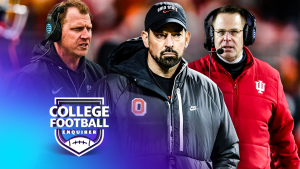Here’s how much teams can cash in for winning the CFP.
The inaugural 12-team College Football Playoff (CFP) is officially here. Once seen as a complicated process that included math equations and plenty of disagreements, college football’s postseason structure has changed a lot over the past three decades.
It started in 1997 when college football’s six biggest conferences joined forces to create the Bowl Championship Series, or BCS. This system used a complex equation to pit the top two teams against each other, ranking teams based on three criteria:
The average of human polls (like the AP Poll and Coaches Poll)
A composite of computer rankings
A strength-of-schedule factor
The problem with this process was that it was constantly changing and intentionally opaque. Over the years, alternative categories like quality wins and margin of victory were added or removed. Many fans had no idea how it worked, claiming it was rigged for the sport’s blue bloods. Worst of all, the Coaches Poll and AP Poll didn’t always agree on the national champion despite a title game taking place.
So, in 2014, the College Football Playoff was established. Rather than having a computer determine the national championship matchup, a committee of 13 people would now vote to determine the country’s four best teams. These four teams were then invited to a knockout-style tournament to crown that year’s national champion.
Some people say that a 13-member committee voting to determine the country’s best teams inherently introduces more bias than a computer algorithm — hello, Florida State! However, almost everyone agrees that more games are better, and given the financial success of the four-team format, the playoff has now been expanded to 12 teams.
The new format is simple: Conference champions from the ACC, Big Ten, Big 12, SEC, and the top-ranked Group of Five school receive automatic berths in the playoff. The four top-ranked league champions get a bye into the quarterfinals, while the lowest-ranked champion plays in the first round with the other seven at-large teams.
First-round games take place on college campuses and are hosted by the highest seed in each game. The quarterfinals and semifinals are run by the more prestigious bowls — Cotton Bowl, Fiesta Bowl, Orange Bowl, Peach Bowl, Rose Bowl, and Sugar Bowl — and the national championship is at a neutral site selected by the committee.
There is a slight quirk with Notre Dame. Even if the Irish are the top-ranked team before the playoffs begin, they will never get a top-four seed (and first-round bye) because they don’t belong to a conference. But by and large, the 12-team format creates more intriguing matchups while generating significantly more money for these schools.
By expanding the College Football Playoff from four to 12 teams this season, there are now 11 games with national championship implications instead of three. This additional inventory enabled the CFP committee to sign a massive media rights extension with ESPN last year worth $7.8 billion over six years, or $1.3 billion annually.
In fact, there is so much additional inventory now compared to years past that ESPN actually sublicensed some of the early round games to TNT. ESPN will still produce the games and use their own broadcast talent. However, TNT is paying ESPN about $25 million per game to slap on the TNT logo and cash in on the advertising revenue.
The individual teams and conferences also benefit from this TV money because each conference receives a percentage of the annual revenue based on its past success.
For example, beginning in 2026 when the new ESPN extension kicks in, SEC and Big Ten schools will receive about $21 million each, while every ACC and Big 12 school will receive $13 million and $12 million, respectively.
The payouts for the Group of Five schools will be lower, at around $1.8 million each, and Notre Dame’s payout as an independent will average about $12 million per year.
But those payments are just a floor. For this year’s playoff, conferences also receive $4 million for each school that gets into the 12-team field. Conferences receive an additional $4 million if one of their teams makes it to the quarterfinals. They get a $6 million check if one of these teams advances to the semifinals and another $6 million payout if that team advances to the national championship game.
Take the Big Ten, for instance. Ohio State, Indiana and Penn State will receive $4 million for making the field. Oregon will automatically receive $8 million because it is already in the quarterfinals with a first-round bye. These payments don’t include the $3 million fee that the conference gets for each team (per round) to cover expenses, and total payouts could approach $50 million if a Big Ten school wins it all.
Television money is a big part of the equation, but there are other factors.
For example, first-round hosts don’t get to keep the expected seven figures in ticket revenue from home games. The College Football Playoff will redistribute ticket revenue to each participating conference once the tournament ends.
Home teams in the first round will get to keep on-field sponsorships in place, making those deals more lucrative if a team consistently reaches the playoff.
But while paint schemes will match a stadium’s appearance during the regular season, the CFP logo will be on every field. The CFP will also provide wraps for the goalposts and control all digital signage, with schools required to cover up all lower-bowl advertising that is seen on television so it can be replaced with CFP sponsors.
There is some uncertainty around how much of a home-field advantage teams will have, given that it’s a unique time of year with winter break and families traveling for the holidays. But the CFP did its best to keep ticket prices low before the secondary market took over, requiring all schools to sell student tickets for $25 and general admission primary market tickets between $100 and $250, excluding clubs and suites.
The CFP also signed 90 deals with hotels in each of the 134 FBS college towns to ensure hotels would be available for the first-round games. And home teams are required to provide visiting teams with 3,500 tickets, including 1,500 in the lower bowl.
The College Football Playoff committee has been clear that it doesn’t know how Year 1 will go. The expectations are high, and including eight additional teams seemed to add more drama to the conclusion of the 2024 college football regular season.
This entire structure may change in a few years. Several conference commissioners are already discussing expanding the playoff from 12 to 14 teams when the new CFP contract takes effect in 2026. But whether that happens, the result is clear.
College football is a big business. The expanded playoff has made it even bigger. And with NIL budgets growing each year, the commercialization of the sport won’t stop here.












